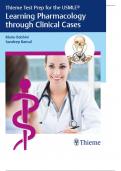Exam (elaborations)
Thieme Test Prep for the USMLE Learning Pharmacology through Clinical Cases Test Bank
- Institution
- 123 University
Medicine is an ever-changing science undergoing continual development. Research and clinical experience are continually expanding our knowledge, in particular our knowledge of proper treatment and drug therapy. Insofar as this book mentions any dosage or application, readers may rest assured th...
[Show more]



